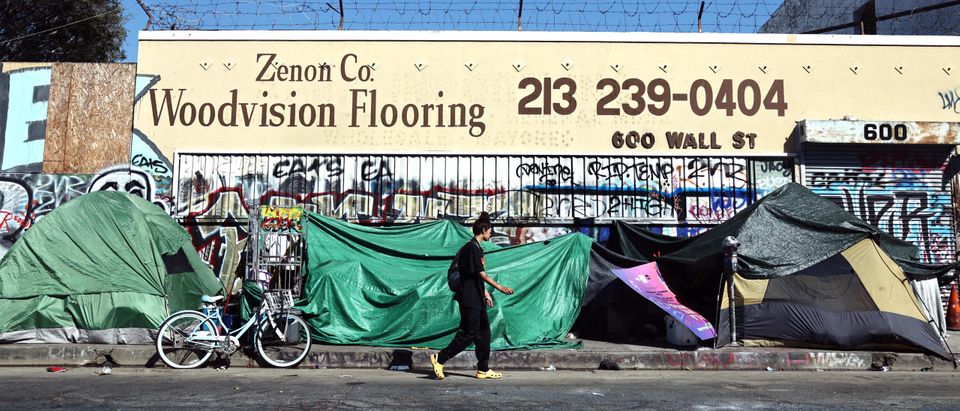California is awash in incomplete and misleading publicly-collected data, and experts say it’s letting policymakers and politicians get away with running the state into the ground.
California Gov. Gavin Newsom and Oakland Mayor Sheng Thao touted in recent months a massive decrease in crime, but it was later revealed that Oakland published misleading non-violent crime data by comparing incomplete 2024 figures with complete figures from previous years, giving the false impression of improving crime to policymakers and the public. The crime statistics in Oakland are indicative of a larger issue in the whole state, which has routinely used misleading and incomplete data to hide the magnitude of serious issues like homelessness, the COVID-19 pandemic and crime that have ultimately harmed average citizens, according to experts who spoke to the Daily Caller News Foundation.
“California is wholly determined by ideology,” Christopher Calton, a research fellow in housing and homelessness at the Independent Institute, told the DCNF. “It’s shocking to me how deep-seated the culture is. The absence of accurate data helps policymakers. [Data] might make them look bad, so they gaslight people into thinking crime is better than it actually is.”
In Oakland, non-violent crimes and burglaries take up to six weeks to appear in crime data, according to the San Francisco Chronicle. The result is an underreported 2024 year-to-date crime figure on weekly reports, where incomplete 2024 numbers are compared against the previous years’ complete numbers, giving a false impression of reduced crime.
Nearly half of all crime in San Francisco goes unreported, according to a poll from local political research group GrowSF collected in September 2023. Violent crime in California has surged in recent years, jumping 26.4% from 2014 to 2022, according to the Public Policy Institute of California (PPIC).
“Data is more accurate to the extent to which people are reporting it,” Calton said. “Victims stop reporting it because it stops being enforced. People just stop calling in.”
Since 2014, California has had Proposition 47 in place, which downgraded the penalties for drug possession and theft under $950 from felonies to misdemeanors. Proposition 47 has been hotly debated in California politics, with critics arguing that the law is responsible for a wave of retail crime, as shoplifting rates climbed by 29% from 2019 to 2022, according to the PPIC.
A spokesperson for Newsom’s office stood by the state’s data, telling the DCNF that it has shown a drop in violent and non-violent crime across cities in California and the state at large, as well as improvements in homicide, larceny, arson, property crime and retail theft. The spokesperson pointed to efforts undertaken by the Newsom administration that have increased efforts to cooperate with local law enforcement across the state, including successes in Oakland, San Francisco and Bakersfield.
In addition to crime data, the California healthcare system also faces a lack of information on behavioral health and mental health.
The California Department of Health Care Services (DHCS) said in an analysis that the data from the state’s behavioral health infrastructure on the need and supply of services is “limited and of mixed quality,” citing an example of the DHCS not knowing how many people were staying under watch for days or weeks while not receiving treatment as they wait for a placement elsewhere in the emergency departments, according to a 2022 DHCS report. In 2020, a state auditor reported that the county-based mental health system contained “disjointed and incomplete” data reporting, saying the “state does not know the extent to which billions in funding has assisted individuals with mental illness.”
Between 2019 and 2021, fentanyl overdose deaths in the state rose by 121%, according to state records. Additionally, California lacked 4,767 psychiatric beds for patients with mental health conditions, according to a 2021 RAND Corporation study.
California announced in May they would allocate $6.8 billion to “counties, cities, tribal entities, nonprofits, and for-profits” to bolster the state’s mental health and behavioral health systems, citing the RAND study and the DCHS assessment as spurring the new funding, according to a May press release.
However, many third parties have had trouble recording important data, with counties, nonprofits and cities receiving large grants from California’s homelessness programs and often not keeping proper tabs on data relevant to their mission, according to Calton. California has spent over $30 billion tackling homelessness and housing since Newsom took office in 2019.
“They weren’t tracking their outcomes. California is acting as a banker government, and these non-profits are not tracking their outcomes,” Calton said. “This is just an example of how there’s no accountability in this. Who can even tell you how effectively it is being spent?”
Homelessness continues to plague California, with the state accounting for 28% of the nation’s entire homeless population, according to a 2023 U.S. Department of Housing and Urban Development report. The state’s homeless population exceeds that of New York, the next highest state, by over 78,000 people.
The homeless population increased by 10,000 between 2021 and 2022. Without proper data, it becomes difficult to verify whether or not parties like counties, cities and nonprofits that receive funding are spending their money to directly tackle homelessness, according to Calton.
California does not know how effective three of its $24 billion homelessness and housing programs were over the past five fiscal years due to a lack of outcome data from organizations involved in the project, according to an April financial audit. The auditor said the programs in question did not have “adequate outcome data to assess the cost‑effectiveness” of the programs, adding that they “lack assurance that these programs represent the best use of state funding.”
Edward Ring, director of water and energy policy at the California Policy Center, told the DCNF that developers are citing success against homelessness when they simply put a roof over people’s heads while having no data on the behavior of people staying in these new developments.
“They say, ‘we need metrics to determine whether these projects are successful,’ and one of the metrics [they] will use is whether or not people stay in their new apartment, and so because they then have created an incentive for people to be kept in their apartments, they don’t monitor behavior at all,” Ring told the DCNF. “It’s a scam that’s making all kinds of people filthy rich.”

California Gov. Gavin Newsom campaigns for President Joe Biden at the Van Buren County Democratic Party’s “BBQ for Biden-Harris” event on July 4, 2024 in South Haven, Michigan. (Photo by Bill Pugliano/Getty Images)
California also used misleading data to support lockdown measures during the COVID-19 pandemic, according to Cato Institute Policy Analyst Marc Joffe.
Joffe told the DCNF that the data used to support COVID-19 lockdowns in the state was lacking in demographic details on mortality. COVID-19’s mortality rate was highly age-dependent, as people over 65 made up 81% of COVID-19 deaths in 2020, according to the CDC.
“In the early stages of COVID, there was interest in knowing the demographics of who died, and counties often failed to provide that information or very wide bands of data, so it was harder to get an idea of what your risk was,” Joffe said. “They were withholding data to support the narrative of lockdowns in California. If [people] understood there was a very low mortality risk for people below 30–40 years old, they may have taken different action.”
During the COVID-19 pandemic, California was one of the more aggressive states when it came to imposing lockdowns, issuing stay-at-home orders for 85% of residents in the state in December of 2020, according to the BBC. Amid the lockdowns, many California residents left the state, resulting in a massive drop in tax receipts, with California seeing a total drop in revenue of $47 billion in 2020 and 2021, according to NBC.
The state is expected to run a $73 billion budget deficit in fiscal year 2024, with a projected $24 billion of tax revenue lost due to people leaving the state. California has already created a plan to make substantial cuts to reconcile the revenue gap. (RELATED: California Is Staring Down The Barrel Of A Yawning Budget Deficit. Can It Even Be Fixed?)
COVID-19 demographic data is not the only thing California has kept from public disclosure, as they are also notoriously slow with reporting financial disclosures on that state’s spending to the federal government, according to Joffe.
“California has the longest delays in reporting its financial statements each year. We recently got their 2022 financial statement in March 2024, and we really do not know when we’re going to see 2023,” Joffe said. “It’s been six years now that the financial statements have come out past the nine months mandated by the federal government. California has the worst tardiness in reporting on its financial statements.”
The financial disclosures are required to maintain California’s credit rating, which determines how easily the state can borrow money, with California’s most recent report being from 2022, according to CalMatters. The state’s credit rating may be in jeopardy if delays persist, according to a 2022 state audit.
“If you have incomplete data and it’s misleading as a result, it may be worth withholding the data until it’s complete,” Joffe said.
All content created by the Daily Caller News Foundation, an independent and nonpartisan newswire service, is available without charge to any legitimate news publisher that can provide a large audience. All republished articles must include our logo, our reporter’s byline and their DCNF affiliation. For any questions about our guidelines or partnering with us, please contact licensing@dailycallernewsfoundation.org.



